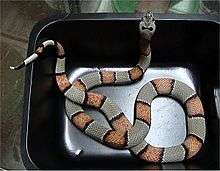Gray-banded kingsnake
| Gray-banded kingsnake | |
|---|---|
| | |
| Scientific classification | |
| Kingdom: | Animalia |
| Phylum: | Chordata |
| Subphylum: | Vertebrata |
| Class: | Reptilia |
| Order: | Squamata |
| Suborder: | Serpentes |
| Family: | Colubridae |
| Subfamily: | Colubrinae |
| Genus: | Lampropeltis |
| Species: | L. alterna |
| Binomial name | |
| Lampropeltis alterna (Brown, 1901) | |
| Synonyms | |
|
Ophibolus alternus Brown, 1901 | |
The gray-banded kingsnake (Lampropeltis alterna), sometimes referred to as the alterna, is a species of nonvenomous colubrid snake. Some sources list two distinct subspecies of alterna, as L. a. alterna and L. a. blairi (Flury, 1950) differentiated by patterning and locale, but research has shown them to be the same.[2]
Distribution and habitat
It is found in the Trans-Pecos/Chihuahuan Desert region of southwestern Texas, southern New Mexico, and northern Mexico.
Description

Gray-banded kingsnakes are moderately sized snakes, can grow up to 4 ft in length, with the average being 3 ft.[3] They have a relatively wide head (when compared to other kingsnake species), and have large eyes with round pupils.
Alterna coloration and patterning vary greatly, but there are two main color morphs, which were once considered separate subspecies: the "Blair's" which has wide red/orange banding, and the "alterna" which has thinner orange/red banding. Both are generally on a grey background with white and/or black accenting. There are many variations on this basic morophology found in the wild and captive bred, with some specimens even lacking orange or red banding entirely.
Behavior
In the wild, gray-banded kingsnakes are not often encountered. They are a common species, but nocturnal and quite secretive. Their natural range is sparsely populated with humans, and many regions are virtually impassable due to the mountainous terrain. In the field herpetologist community, finding this snake in the wild is often considered to be a laudable feat. Most that are located are found along the roadways that transect their habitat in the Trans Pecos region. Alterna generally have a calm disposition and are not prone to defensive reactions, like biting.
Diet
Gray-banded kingsnakes feed primarily on lizards. They will occasionally feed on small rodents, frogs, and the eggs of ground nesting birds, lizards, and other snakes.

Reproduction
Alterna are oviparous, laying clutches 3–13 eggs in early summer, which hatch in approximately 9 weeks. Hatchlings are around 10 inches in length.[4]

Domestication
Gray-banded kingsnakes are commonly kept in captivity and are fairly easy to come by in the exotic pet trade. Due to their relatively small size, calm dispositions, and astounding array of pattern variations they are frequently captive bred. Many breeders of alterna are strict about keeping locality bloodlines pure, and will only breed snakes from the same region, though, as market demand decreases this is becoming less and less important to some breeders. Cross breeding with other species of kingsnake, like the Neuvo León kingsnake, Lampropeltis mexicana thayeri is fairly common as well.
Resources
- ↑ Hammerson, G.A. & Santos-Barrera, G. (2007) Lampropeltis alterna. In: IUCN 2012. IUCN Red List of Threatened Species. Version 2012.2.
- ↑ Jeff Barringer. A Short History of the Lampropeltis alterna (Gray-banded Kingsnake). Kingsnake.com. Retrieved on 2013-01-02.
- ↑ Grey Banded King Snake Care Sheet. TheKingSnake.co.uk. Retrieved on 2013-01-02.
- ↑ Herps of Texas: Lampropeltis alterna. Zo.utexas.edu. Retrieved on 2013-01-02.
See also
| Wikimedia Commons has media related to Lampropeltis alterna. |
